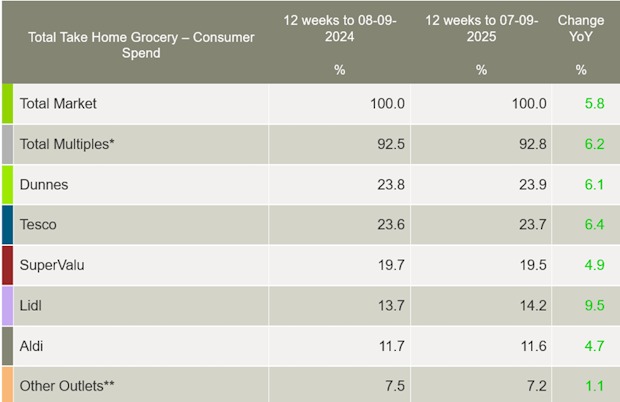Latest data from Worldpanel by Numerator shows take-home grocery sales in Ireland rose 6.1% in the four weeks to 7 September 2025, boosted by back-to-school spending and surging inflation.
With many parents preparing for the new term, store visits increased by 0.7%, although shoppers picked up fewer packs per trip. Overall, shoppers spent an additional €68.8m on groceries compared to the same period last year.
Meanwhile, grocery price inflation accelerated from 5.4% to 6.3% over the latest 12-week period, with Irish shoppers seeking out promotions and own-label products as a result.
Emer Healy, Business Development Director at Worldpanel by Numerator, commented: “As the new school term began in early September, we saw spending on typical lunchbox staples increase across many households with children. Over the latest four-week period, shoppers spent an additional €5.3m on sweet bakery items, fresh fruit, breakfast cereals and porridge, savoury snacks and yoghurt. Convenience is also a priority, with an extra €1.6m spent on fresh and frozen ready meals and cooking sauces compared with last year.”
Households with children also made greater use of online shopping, spending an additional €6.6m compared with the previous month. They also added €1.2m more to their baskets on sliced meats, yoghurts, breakfast cereals and biscuits as they stocked up for school lunches.
With household budgets being squeezed by inflation, shoppers took advantage of promotions, spending €758m on promotional lines during the 12-week period, an increase of 8.2% compared to the previous year.
Promotional spending now makes up 21.5% of all grocery sales in Ireland. Key categories driving this growth included laundry, water, squash and smoothies, all of which performed ahead of the total market for promotional lines.
While brands grew behind the total market (+5.8%) with growth slowing to 3.9% in the last 12-week period, Irish shoppers still spent an additional €62.6m on branded products.
Own-label saw stronger growth at 6.6%, with premium lines the standout performer, up 16.2%. Shoppers spent nearly €19.4m extra on these ranges. Premium own-label lines saw a boost in confectionery (+18.4%), soft drinks (+24.8%) and alcohol (+36%).
Brands currently hold a 47.2% value share of the total market in Ireland, while own-label products hold a 46.9% value share.
Online continued to gain ground, with sales rising 6.3% year-over-year to take a 5.8% value share of the market. Shoppers spent an additional €12m online during the period, helped by an influx of new customers who contributed €7.7m to overall performance. Nearly 18% of Irish households bought their groceries online during this time.
Looking at individual retailers, Dunnes controlled 23.9% of the market share after seeing slower sales growth of 6.1% year-on-year.
Tesco held 23.7% of the market, with value growth of 6.4%. Shoppers increased their trips to the retailer’s stores by 1.3% and, together with new shoppers, contributed an additional €23.7m to Tesco’s overall performance.
SuperValu held 19.5% of the market with growth of 4.9%. Consumers made the most shopping trips to this grocer, averaging 24.7 trips over the 12 weeks, up 9.6% year-on-year. The increase in shopping trips contributed an additional €61.6m to its performance.
Lidl’s market share increased to 14.2%, with a growth rate of 9.5%, the best performance among all retailers. The discounter also saw shoppers pick up more volume in store, up 2.5%, contributing an additional €11.5m to its overall performance.
Aldi’s share was 11.6% after recording growth of 4.7%, with increased store trips and new shoppers driving an additional €16.1m in sales.

NAM Implications:
- The discounters’ 25.8% combined share of market, greater than Dunnes…
- …must continue to be a concern for the Irish mults.
- With a population patently prepared to shop around for value…
- …and ‘trade down’ to own label.
- Although the promise of incremental revenues via Retail Media will be some comfort for retailers with a near 50/50 brand / own-label assortment balance…
- …vs. discounters only able to offer First Party Data on national brands to their suppliers.




